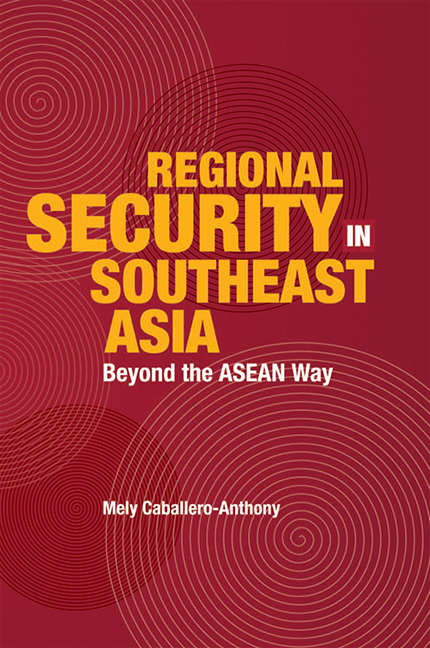Book contents
- Frontmatter
- Contents
- Acknowledgements
- INTRODUCTION: Regional Security in Southeast Asia: Beyond the ASEAN Way
- 1 Regionalism and Regional Security: Locating ASEAN
- 2 ASEAN's Mechanisms of Conflict Management: Revisiting the ASEAN Way
- 3 ASEAN and the Cambodian Conflict: Testing the Limits of the ASEAN Way
- 4 ASEAN Regional Forum: Extending the ASEAN Way in Managing Regional Order
- 5 ASEAN's Track Two Diplomacy: Reconstructing Regional Mechanisms of Conflict Management
- 6 The Asian Economic Crisis and Other Challenges: Turning Points Beyond the Comfort Zone?
- 7 ASEAN and Civil Society: Enhancing Regional Mechanisms for Managing Security
- 8 Conclusion: Beyond the ASEAN Way
- APPENDIX I Declaration of ASEAN Concord II (Bali Concord II)
- APPENDIX II Recommendations of the High-Level Task Force on ASEAN Economic Integration
- APPENDIX III ASEAN Vision 2020
- APPENDIX IV Declaration of ASEAN Concord
- Selected References and Further Readings
- Index
- About the Author
3 - ASEAN and the Cambodian Conflict: Testing the Limits of the ASEAN Way
Published online by Cambridge University Press: 21 October 2015
- Frontmatter
- Contents
- Acknowledgements
- INTRODUCTION: Regional Security in Southeast Asia: Beyond the ASEAN Way
- 1 Regionalism and Regional Security: Locating ASEAN
- 2 ASEAN's Mechanisms of Conflict Management: Revisiting the ASEAN Way
- 3 ASEAN and the Cambodian Conflict: Testing the Limits of the ASEAN Way
- 4 ASEAN Regional Forum: Extending the ASEAN Way in Managing Regional Order
- 5 ASEAN's Track Two Diplomacy: Reconstructing Regional Mechanisms of Conflict Management
- 6 The Asian Economic Crisis and Other Challenges: Turning Points Beyond the Comfort Zone?
- 7 ASEAN and Civil Society: Enhancing Regional Mechanisms for Managing Security
- 8 Conclusion: Beyond the ASEAN Way
- APPENDIX I Declaration of ASEAN Concord II (Bali Concord II)
- APPENDIX II Recommendations of the High-Level Task Force on ASEAN Economic Integration
- APPENDIX III ASEAN Vision 2020
- APPENDIX IV Declaration of ASEAN Concord
- Selected References and Further Readings
- Index
- About the Author
Summary
INTRODUCTION
The previous chapter discussed ASEAN's embryonic mechanisms of conflict management, which the organization had developed over the years since its inception. While it can be said that these mechanisms have proved successful in dealing with certain inter-state conflicts, assessing the effectiveness of these mechanisms in other types of conflicts, particularly if they are extramural and external to the grouping have to be qualified. As emphasized in the earlier chapter, the effectiveness of certain mechanisms would depend largely on the nature of the conflict and the kind of objectives set out to resolve the conflict. In this regard, ASEAN's role in the resolution of the Cambodian conflict best exemplified the limitations of its mechanisms as it attempted to manage an external conflict involving neighbours, Cambodia and Vietnam, that at that time were not yet part of the ASEAN grouping.
In describing ASEAN as a conflict manager in the region, Muthiah Alagappa had noted that ASEAN did not actually envisage conflict prevention, containment, and termination roles with regard to external conflicts. Instead, what it had hoped to achieve was for its proposals for peace and security to cover all of Southeast Asia. Hence, ASEAN's conflict prevention measures specifically had not applied to non-ASEAN Southeast Asia. In this regard, ASEAN's involvement in the Cambodian conflict offers interesting insights on examining the extent to which its mechanisms had been useful or inadequate in the search for the political settlement to the conflict. To appreciate the extent and limits of ASEAN's modalities, one must be able to track the various initiatives that member states of the grouping undertook throughout the duration of the Cambodian conflict. This chapter will, therefore, begin with a somewhat discursive, chronological account of the development of the Cambodian conflict and ASEAN's involvement in the resolution of the conflict.
- Type
- Chapter
- Information
- Regional Security in Southeast AsiaBeyond the ASEAN Way, pp. 83 - 112Publisher: ISEAS–Yusof Ishak InstitutePrint publication year: 2005

